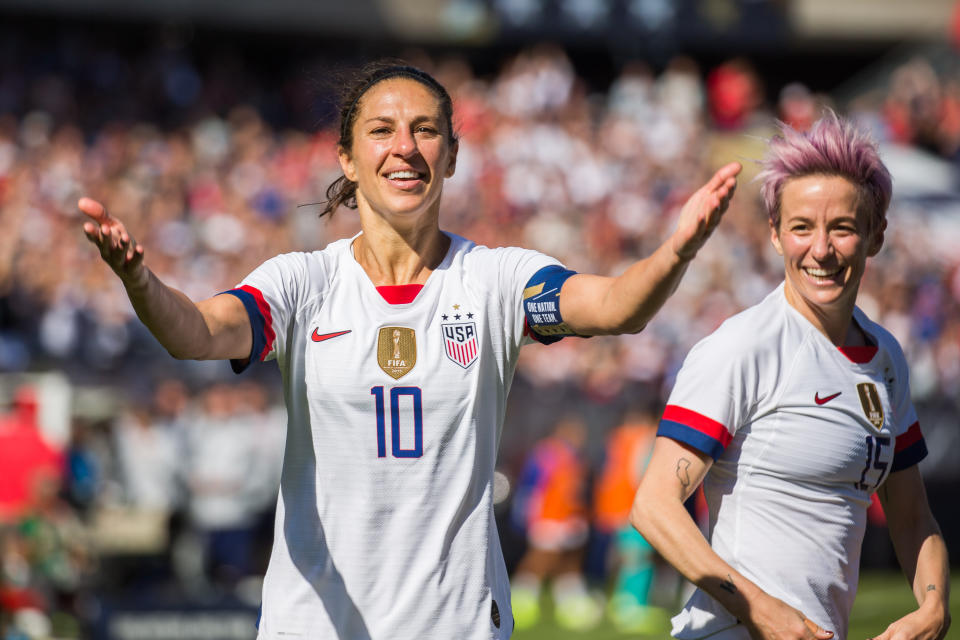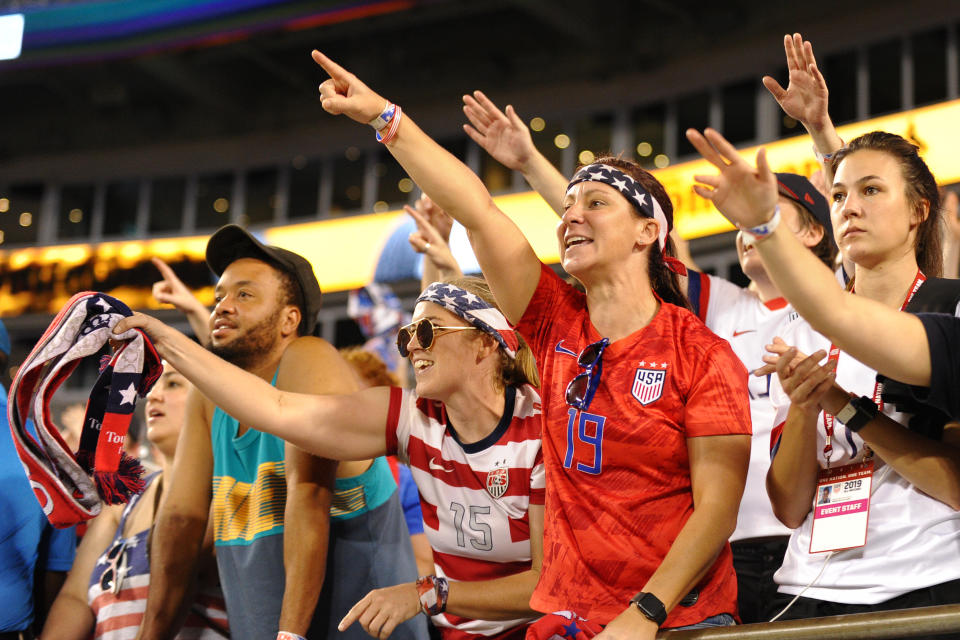Why Nike didn't have enough USWNT World Cup jerseys to meet demand — and what it cost the players and fans

When the U.S. women’s national team lifted the World Cup in France, the hottest new piece of fashion in sports had been born. The four-star version of the USWNT’s retro-inspired red, white and blue jersey was the item everyone seemed to want.
There was a problem, however: Barely anyone could find it in stores or online. Nike, the official kit sponsor for the USWNT, didn’t anticipate the high demand for USWNT jerseys and didn’t have enough to sell to fans who wanted them.
After the Women’s World Cup ended, Nike initially made only about 1,000 jerseys available and they sold out immediately. As larger quantities of jerseys were released in men’s, women’s and youth sizes, they also sold out quickly. Nike underestimated the demand or wasn’t able to produce jerseys quickly enough – or likely both – and months went by where fans who wanted four-star USWNT jerseys couldn’t find them.
The company shortened its turnaround time by adding an extra star to the top of existing three-star jerseys. Beginning next year, USWNT kits will feature the permanent configuration with four stars across in a single line to represent the team’s four World Cup victories. Yet that shortcut wasn’t enough to meet demand.
Nike should’ve had some idea that USWNT jerseys would be a hot item. The company announced during the World Cup — before the USWNT won it — that the three-star USWNT home jersey was Nike’s best-selling single-season soccer kit ever. That was despite the jersey being released widely to retail in May, well after Nike first unveiled the kits at a huge publicity event in March and the USWNT started wearing them in April.
Reached by Yahoo Sports, a Nike spokeswoman said in a statement: “We planned for a significant number of the jerseys and continue to restock based on demand. It’s been wonderful to see the continued growth and popularity of our USWNT and other female sports created by the energy of this summer’s tournament.”
The four-star jerseys started to be restocked at the end of September, although most sizes are already sold out on U.S. Soccer’s website. They will continue to be released into the market during October, a Nike spokeswoman said, but she could not say whether they would be restocked when the current batch sells out. The company does not publicly share information about the volume of jerseys produced or sold, she added.
If previous USWNT kit releases are any guide, however, it’s a good bet that the World Cup jerseys will not be restocked and instead an all-new kit design will be released in the spring. In that case, the World Cup jerseys may be sold out before the holiday season even hits. (A U.S. Soccer spokesman directed all questions about its jerseys to Nike.)

That has been frustrating for the players on the USWNT, who, as part of a new business endeavor, are in a position to benefit directly from the sale of player-specific jerseys. After all, jerseys need to be available in the first place for fans to buy customized versions with their favorite player’s name on the back.
“It's interesting to hear announcements about player jerseys selling out as if it's a positive thing,” said Steven Scebelo, the president of REP Worldwide, which spearheads the USWNT licensing program. “We saw it with the women's national team: 'Wow, jerseys sold out! What a success!' It was successful, but they could've sold more.”
“There is definitely opportunity being lost,” he added to Yahoo Sports. “More jerseys could be sold for the U.S. women's national team. There's no doubt.”
In the period during and immediately after the World Cup, partners of the USWNT Players Association sold more than 15,000 jerseys with players’ names on them, which means the USWNT earned royalties on those sales. But for several weeks after the tournament until September, there were zero sales because no jerseys were available anywhere.
At a time when demand for the jerseys was highest, the USWNT and its licensed retailers — Fanatics, Legends and Sports Endeavors — likely missed out swaths of sales, and fans who had placed preorders for jerseys from Nike were left to wonder on social media if their jerseys would ever arrive.
Fanatics sold out of some of its SKUs before the Women’s World Cup even started. And as of Thursday, Fanatics had only four-star men’s away jerseys available in small for player customization — all the other replica jerseys were apparently sold out. (Men’s versions of the USWNT kits were made available at launch for the first time this year after much pushing from the USWNT Players Association — and that bet clearly paid off.)
There doesn’t seem to be a strong incentive for Nike to improve its ability to meet these demands, however. On a recent earnings call, Nike CEO Mark Parker revealed that the company's apparel revenue from the 2019 World Cup was four times what it earned during the 2015 tournament — a big win for Nike, to be sure — and he boasted about the company’s growth in its women’s business.
But for the USWNT Players Association, which wants to see fans spreading the word about the team, and for fans who want to own jerseys, there’s a lingering feeling that there must be a better way forward.
One model could come from the NFL, where Nike is the official jersey sponsor. Nike will no longer produce the jerseys and merchandise sold to fans — instead, as part of a 10-year deal, all adult retail products for the NFL will be made by Fanatics, even though the jerseys will still have a Nike swoosh.
That sort of partnership can be a game-changer for everyone involved.

Nike can focus on innovating and producing their own lines — all while getting the advertisement of players wearing the company logo and a royalty on Nike’s designs. But Fanatics has the ability to produce jerseys on a made-to-order basis, meaning they won't have to risk stockpiling inventory and trying to predict which jerseys will sell best — they can sell to the demand that exists.
The USWNT's player union and REP Worldwide, its licensing partner, would prefer to see U.S. Soccer and Nike to move in that direction. For the USWNT Players Association, which has been building its licensing program up from scratch as a new way for players to capitalize on their success, player jerseys figure to be a larger source of revenue than for huge organizations like Nike and U.S. Soccer.
Some of the relationships that could get an agreement off the ground already exist, too. Outerstuff, which manufactures the NFL’s youth jerseys on behalf of Nike, is already a licensee with the USWNT Players Association and has proven its ability to turn around new product with minimal lead times.
“If Nike and U.S. Soccer were willing, they could probably have an Outerstuff deal within a week,” Scebelo said. “We signed Outerstuff to a USWNTPA fan gear license within a matter of weeks while the World Cup was happening because they wanted to capitalize on the timing of tournament. If Nike could similarly come together with Outerstuff, as they do in other sports, that would check the box on children's jerseys.”
For now, it appears the current system is staying put. The long lead times in bringing products to market isn’t just on Nike’s end with its manufacturing, but a byproduct of the complicated distribution network that helps jerseys — and the officially licensed letters and numbers for customization — reach the end consumers.
That means fans will have to scoop up the USWNT’s four-star 2019 World Cup jerseys when they see them for sale. Once they sell out, fans might never have the chance again.
Caitlin Murray is a contributor to Yahoo Sports and her book about the U.S. women’s national team, The National Team: The Inside Story of the Women Who Changed Soccer, is out now. Follow her on Twitter @caitlinmurr.
More from Yahoo Sports:
